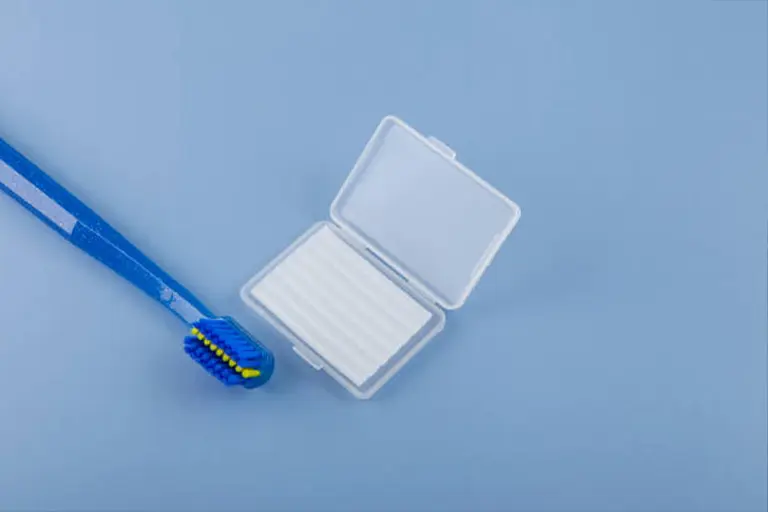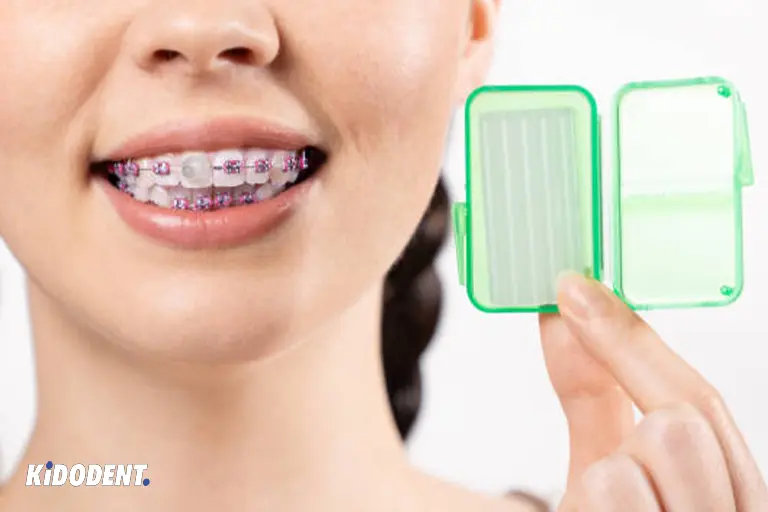Orthodontic wax or dental wax is used to prevent irritations and damage to the soft tissues like gums, lips, and inside of our cheeks from braces or other metal orthodontic appliances.
In dentistry, you may have heard that dentists use wax to take an impression of teeth for dentures, restoration of parts of teeth, or design and size of orthodontic appliances. But orthodontic wax, which we mean here, is a piece of soft material used between braces edges that are broken, loose, or damaged to prevent irritating our lips, gums, and other soft oral structures.
What is orthodontic wax made of?
Orthodontic wax can be chemically made, or it is also available naturally in trees or from insects. Paraffin wax, which is obtained from petroleum, is one type of orthodontics wax. Other common types include carnauba wax and beeswax. Carnauba wax is extracted from trees and beeswax is an insect-based wax.
Is orthodontic wax necessary?
Metal orthodontic tools like braces or even removable appliances like aligners may rub against your gums, lips, and cheeks. But, sometimes this rubbing can be intense and cause soreness and redness to the oral soft parts of your mouth. This constant rubbing can result in great discomfort and pain.
You may look for ways to prevent your uncomfortable irritations and pain before making an emergency orthodontic appointment. The best solution is using orthodontic wax to stop braces from rubbing. It is a great topical prescribed by orthodontists.
Is orthodontic wax safe?
You shouldn’t worry about the orthodontic wax. It is recommended by orthodontists when appliances like braces have been damaged during your treatment and are loose in your mouth due to pressures and broken parts of these tools. Wax is not a drug that you ingest and you just apply that where braces rubbing is causing you pain.
You may panic when suddenly swallowing the wax. First, try not to put large amounts for application and second don’t worry if you ingest some parts of the wax. Swallowing the wax, especially natural-based wax is not dangerous and it is non-toxic.

How do you apply orthodontic wax?
First, locate the exact location where you feel discomfort and irritation to your soft tissues in or around your mouth. Dry the area with a piece of clean cloth. Apply the wax between the braces’ wires, brackets, or any other metals that have come loose or rough parts of the orthodontic appliance, where you feel the pain.
Orthodontic wax is easy to form because of its softness and malleability characteristics. So, similar to creating a mold, you can easily shape the wax into the size and form that you need.
When do braces and orthodontic appliances cause irritation?
Sometimes fixed orthodontic appliances like braces or removable clear aligners or dentures in the mouth are not well-fit in the mouth, which makes them loose or very tight around your lips, gums, and inside of your cheeks. These tight and constant frictions of orthodontic tools are at first common and you should get used to wearing these appliances.
But, if pain and discomfort from wearing braces don’t go away and irritation or friction from specific parts of braces are just nonstop, you need to seek your orthodontist’s advice. Maybe something has gone wrong with the braces like the design, size, and damage to the appliance. This is when you need to visit the orthodontist to fix the braces in place and remove any defects from the appliance or the part that needs repair.
What happens when you don’t use orthodontic wax?
Cuts and abrasions that are caused by braces can be painful if your appliance is too rough or very uncomfortable for a long time. If you ignore sores and scratches of braces that are fixed in your mouth, healing of the area can take weeks. Therefore, you don’t want another challenge while undergoing your orthodontic treatment. This is why orthodontic wax is necessary and shouldn’t be ignored during your orthodontic period.
It is usually included as part of the orthodontic kit you receive as a care topical tool. You can also buy the wax from online retailers or your local drugstore.
Can you eat while having orthodontic wax on your braces?
Orthodontic wax is sticky because it should hold between your braces and the area in your mouth that is irritating. So, when you eat something, food debris can stick to the wax and between your braces. Avoid eating when the wax is applied. You can remove the orthodontics wax before eating.
Can you drink while orthodontic wax is on?
Drinking is not a good idea while orthodontic wax is applied between your soft tissues and braces. The reason is because of that you may drink coffee, tea or a hot or very cold drink that can change the shape of the orthodontics wax. Drinking may cause the wax to melt or constrict which changes the wax pattern and may spoil its properties.
Are there any alternative ways instead of orthodontic wax?
Sometimes, people may come up with other ways to prevent braces from rubbing against their gums or cheeks. Using chewing gums and applying a piece of cloth are some ways. But these are just temporary alternatives and are not recommended if you can access the orthodontics wax.
First, chewing gum doesn’t have the characteristics of the wax. It can be too sticky and cause a mess and it cannot hold in place as the wax does.
Also, if you use a piece of cloth, you may apply too much force to the other parts of your braces which may cause breakage or distortion on the appliance. Besides, cloth may easily get dirty and doesn’t sound hygienic.
Important tips on orthodontics wax
- Orthodontic wax is not just a suitable kit for any brace wearer but those that have retainers, dentures, bridges, and other orthodontics appliance wearers can benefit from that.
- It is an adjunct to your orthodontic treatment and is prescribed by orthodontists for emergencies.
- You need to consult with your orthodontist about uses right before any emergency happens.
- You may need frequent application of the wax if the wax is dirty or not useable until you see your orthodontist.
- Infection from too much abrasion, cuts, and sore areas around your braces can easily be prevented by using orthodontic wax.
